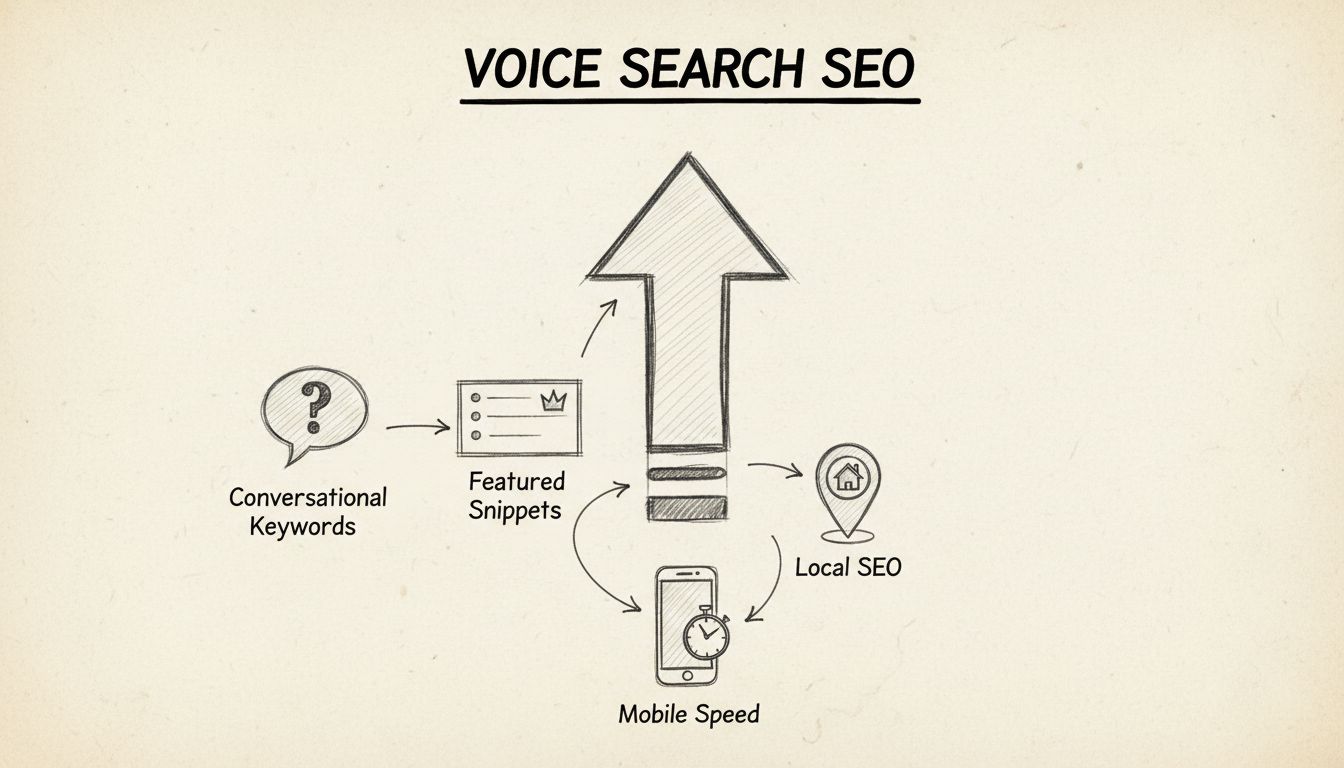
Should I Focus Solely on Voice Search Optimization? A Balanced SEO Strategy
Learn why balancing voice search optimization with traditional SEO is essential. Discover how to optimize for both voice and text searches to maximize your reac...

Discover 5 essential laws to optimize your website for voice search, including long-tail keywords, fast loading, featured snippets, and local business listings to stay ahead in the voice search revolution.
The rise of voice search technology has undeniably transformed how users access information and engage with digital platforms. As more and more people turn to voice assistants like Amazon Alexa, Google Assistant, and Apple’s Siri to search for information, make purchases, and manage their daily tasks, it is becoming increasingly important for businesses to adapt and optimize their online presence accordingly.
Voice search optimization goes beyond traditional SEO practices, requiring a deeper understanding of user behavior and the nuances of natural language processing. This means that businesses must not only focus on keywords and meta tags but also consider the conversational tone and context of voice queries to ensure their content remains relevant and easily discoverable.
According to Voice Search for Local Business Study, voice search is quickly becoming a usual deal among U.S. Internet searchers. Here are the findings:
The same study also suggested that people use various devices to perform a voice search. For example, among the participants who used voice search function to find a local business in 2017-2018, 56 percent were smartphone users, 28 percent were desktop or laptop users, 26 percent were tablet users, and 18 percent were smart speaker users.

With the voice search rapidly developing and more consumers using it, technology is predicted to make even more impact in the next years. For example, Gartner’s predictions are that 30 percent of web browsing sessions will be done without a screen on devices such as Google Home and Amazon Echo by 2020.
With the current share of voice searches in mobile queries being 20 percent and increasing, it makes a perfect sense to optimize your website to be friendly to this ever-popular technology and get higher in voice search results.
In this article, we’ll cover five laws for everyone interested in an effective voice search optimization as well as tips and takeaways to help you meet the need of voice searchers.
“Voice search and traditional search are different when it comes to keywords because the former uses more natural, conversational language,” explains Brian Frye, a digital marketer at Proessaywriting. “Essentially, a voice search is a conversation with a device, so the keyword length also increases due to the nature of how people speak.”
For example, when we type into Google search, we tend to be as short as possible. The reason is, we don’t need to type a long query because the search engine will provide relevant results anyway. For example, we may type “coffee shop near me” into the search, but we’d say “Siri/Cortana/Alexa/OK Google, what are the best coffee shops near me?” because it’s a more natural phrase to say.
That brings us to one of the most important factors in voice search optimization: long-tail keywords and question phrases.
They are longer and more specific than typical keywords and resemble natural, conversational language much better. See the following examples.
Traditional keyword phrase: “customer support software”
Long-tail keywords: “live chatcustomer support software for ecommerce websites,” “best live customer support software for small ecommerce businesses.”
Optimizing your content using long-tail keywords has many benefits. First and foremost, they are much more specific than generic “head” keywords, so they ensure that you won’t have as much competition as you would have with generic keywords.
Second, they are more relevant compared to generic keywords. For example, the aforementioned “live chat customer support software for ecommerce websites” phrase is highly relevant to a specific niche – live chat tools for online businesses – therefore, they reflect the intent of the searcher more precisely.
Third, long-tail keywords may decrease the search volume on your site but increase the quality of visitors. For example, a person who found your website offering live chat for ecommerce businesses using a keyword phrase as specific as “live chat customer support software for ecommerce websites” is definitely interested in exploring this software than the one looking for “customer support software,” which is a much broader term.
Finally, explore your options for including your long-tail keywords in question phrases that begin with When, Who, Where, Which, and What.
One of the most important voice search ranking factors is the speed of your website. It all started with Google: on July 9, 2018, the search giant announced that “the speed” update was rolling out for all users. For websites, it meant one thing: if they wanted to be featured in voice search results, they need to be fast and mobile-friendly (since a large share of voice searches is done on mobile devices).
Further studies confirmed that voice search results came from faster-loading pages. For example, a recent Backlinko study found that the average voice search result loaded in about 4.6 seconds, which was 52 percent faster than an average page in traditional search (8.8 percent).

Well, since page speed is a critical factor, here are the steps you need to take to ensure that you have this one covered:
The voice search revolution is gradually making Google an “answer engine” rather than “search engine” because the search engine strives to provide immediate answers to improve the experience of the users. The immediate answers come in the form of featured snippets, a box at the top of Google’s search results page showing an answer to the searcher’s question.
Here’s an example of a featured snippet giving the answer to the query: “Who is the coach of New England Patriots?”

Being featured in snippets increases the exposure and visibility of your website and inspires the sense of authority and trust – after all, it was selected as a preferred source of information by Google!
To increase the chance of being the preferred source of information, you need to:
Try using a tool like Answer the Public to determine what long-tail keyword phrases Google users are asking about your topic. For example, here’s a question-based graph generated for keywords “voice search.”

If your content is difficult for people to read, Google will not rank it very high (it won’t get to be in featured snippets, that’s for sure). Here are the most important ways in which you can make your content voice-search friendly.
Since 46 percent of voice search users prefer it to find local businesses, it’s critical for you to claim your Google My Business Listing . The businesses that claimed the listing appear in the local 3-pack and on Google Maps like this:

Having a listing is an easy way to help your potential customers find you and share the essential information about your business, such as:
If you still haven’t claimed your listing, you won’t be readily available for voice search, therefore, you’re allowing your competition to get ahead of this growing trend. If more and more people use “near me” searches to find local businesses, this means that you need to be there for them.
Let’s see how a Google user might search for your business.
The first way is to include the product/service and the desired location, e.g. “Sushi delivery in Atlanta.” In this case, you’ll have to optimize your website for local keywords in order to appear in Google’s search results.
The second way is to ask Google for businesses “near me,” e.g. “Sushi delivery near me.” To deliver relevant results for queries like this, Google relies on the location of the user and turns toward Google my Business listings. Your business should be there waiting to get displayed.
To ensure that you have the best chance to be the preferred businesses, follow these tips:
Although the future of voice search is far from predictable, it’s clear that this trend is gaining considerable traction and is not likely to slow anytime soon. With more and more people using voice search function to look for businesses/content, the technology is changing the way we search.
That’s why you should make voice search optimization an important part of your digital marketing strategy. It can bring you a lot of new customers , so doing it is a must for a modern online business. Don’t forget to follow the laws described here to make sure that you’re doing everything correctly. And remember: don’t just optimize for Google. Tailor your content to the people who are using it to find you!
Long-tail keywords are longer, more specific phrases that reflect natural, conversational language. They are crucial for voice search optimization because users tend to speak in complete questions or sentences, making your content more likely to match their queries.
Fast-loading, responsive websites are favored by search engines for voice search results. Studies show that voice search results come from pages that load significantly faster, improving user experience and search rankings.
Featured snippets provide quick, direct answers to user questions at the top of search results. Optimizing your content for featured snippets increases the chance of being selected as the answer for voice queries.
No. While 20% of searches are voice-based, traditional SEO still applies to the remaining majority. Continue balancing conventional SEO with voice optimization for maximum reach.
A verified Google My Business listing helps your business appear in local voice searches, especially for 'near me' queries. Accurate and updated listings increase your chances of being found by voice search users.
Tom Jager is professional blogger. He works at A-writer. He has degree in Law and English literature. Tom has written numerous articles/online journals.

Transform your SEO strategy and capture more customers by optimizing for the growing trend of voice search. Learn actionable steps to increase your visibility.

Learn why balancing voice search optimization with traditional SEO is essential. Discover how to optimize for both voice and text searches to maximize your reac...

Voice search refers to the searches done using your voice. Voice searches account for 20-25% of searches. Learn how voice search will affect SEO.

Discover why long-tail keywords are essential for voice search optimization. Learn strategies to capture conversational queries and boost your online visibility...
Cookie Consent
We use cookies to enhance your browsing experience and analyze our traffic. See our privacy policy.